Top Solar-Powered Outdoor Lighting Options
Solar-powered outdoor lighting has become a popular choice for homeowners and outdoor enthusiasts, offering an energy-efficient and eco-friendly way to brighten up outdoor spaces. These lights use the sun’s energy during the day to power themselves at night, making them a cost-effective and sustainable alternative to traditional wired lighting. With no need for electrical outlets or complex installations, they are an excellent solution for gardens, patios, driveways, and more. Plus, they come in various designs and brightness levels, catering to both decorative and practical needs.
Whether you’re aiming to create a cozy ambiance for outdoor gatherings or enhance the safety of your property with motion-sensing floodlights, solar-powered lights can do it all. This guide will help you explore the best options available, focusing on their features, types, and benefits. By the end, you’ll have all the information you need to choose the right solar lighting solution for your home or outdoor area.
Why Choose Solar-Powered Lighting?
Solar-powered lighting is more than just an environmentally friendly option—it’s a practical solution that meets modern needs. Here’s why these lights are a smart choice for any outdoor space:
Cost-Effective and Energy Efficient
One of the biggest advantages of solar lights is their cost-saving nature. They use sunlight to recharge during the day, which means no electricity bills and no need for extensive wiring. Over time, this results in significant savings compared to traditional lighting options.
How it works:
- Solar panels absorb sunlight and convert it into electricity.
- This electricity is stored in a rechargeable battery, powering the light after dark.
Eco-Friendly and Sustainable
Solar lights are a greener alternative to traditional electric lights. By harnessing renewable energy, they reduce your carbon footprint and help combat climate change. They’re a small but impactful step toward creating a more sustainable future.
Key benefits for the environment:
- No reliance on fossil fuels.
- Reduced greenhouse gas emissions.
Easy Installation
Unlike wired lighting, solar-powered options don’t require professional installation or complex setups. Most models are ready to use right out of the box—just place them where they can receive sunlight, and they’ll do the rest.
Where to use them:
- Gardens and pathways.
- Decks, patios, and fences.
- Driveways and remote areas with no electrical access.
Low Maintenance
Once installed, solar lights require minimal upkeep. Regular cleaning of the solar panel is usually enough to keep them running efficiently. Their durable construction often includes weatherproof materials, so they can withstand rain, snow, and sun exposure.
Tip: Look for models with replaceable batteries to extend their lifespan.
Versatility in Design and Function
Solar-powered lights come in a variety of styles, from decorative string lights to powerful floodlights. This versatility allows you to choose options that suit your specific needs, whether it’s enhancing security, creating a welcoming ambiance, or simply lighting up your pathways.
Popular types:
- Decorative lights for ambiance.
- Functional lights for security and safety.
By choosing solar-powered lighting, you’re investing in a solution that’s practical, environmentally responsible, and tailored to modern lifestyles. It’s not just about lighting your space—it’s about doing it smartly and sustainably.
How Solar Lights Work
Solar lights are a brilliant combination of technology and simplicity. They rely on renewable solar energy to provide illumination, making them eco-friendly and cost-efficient. Here’s a breakdown of how they work:
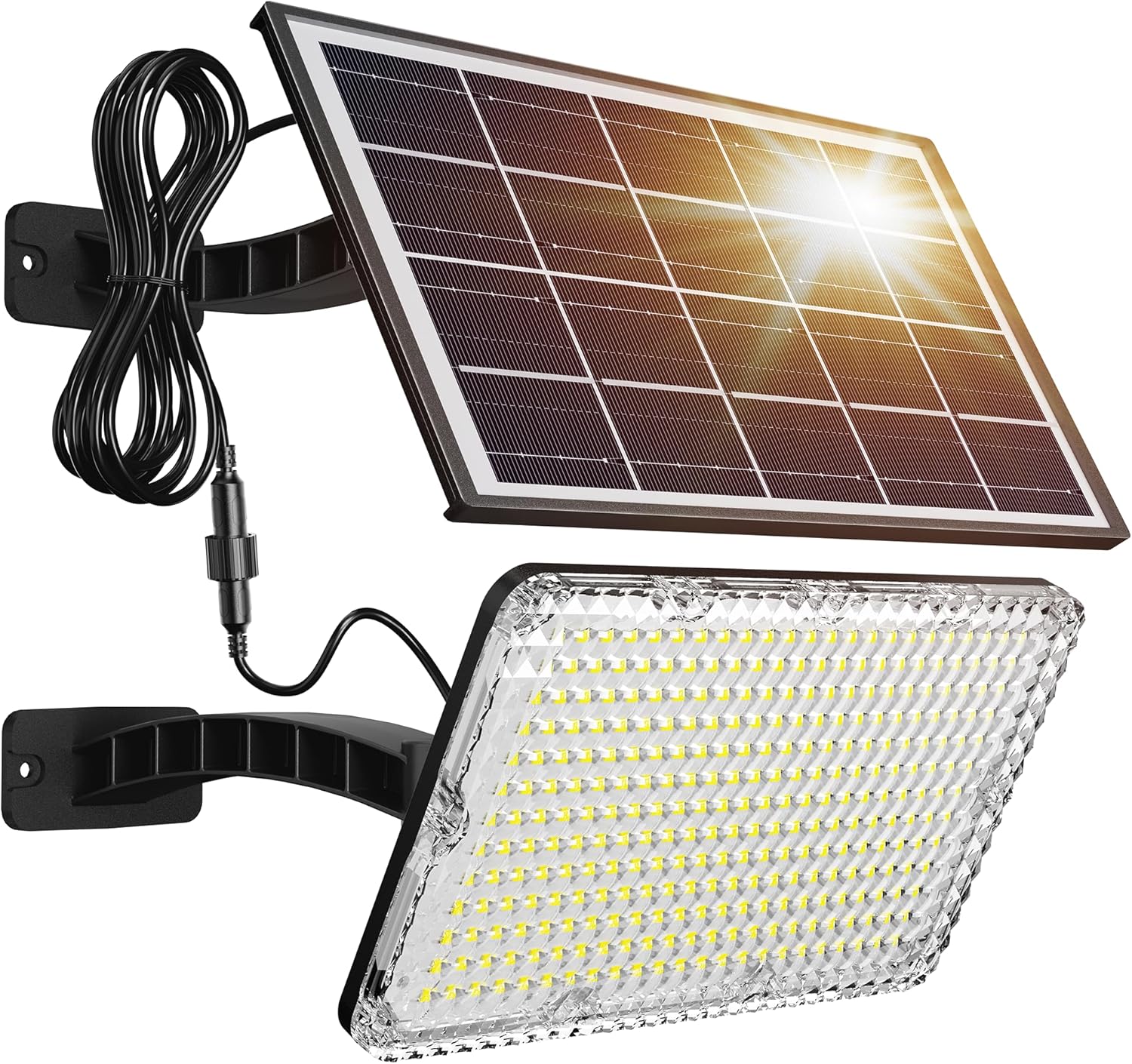
Solar Panels: Capturing Sunlight
At the heart of every solar light is a solar panel. These panels are usually made of photovoltaic (PV) cells, which convert sunlight into electricity.
How it works: When sunlight hits the PV cells, it excites electrons, creating an electric current.
Types of panels:
- Monocrystalline: High efficiency, ideal for low-light conditions.
- Polycrystalline: More affordable, slightly less efficient.
Tip: For the best performance, place the solar panel where it can receive direct sunlight throughout the day.
Rechargeable Battery: Storing Energy
The electricity generated by the solar panel is stored in a rechargeable battery, which powers the light after dark.
Common battery types:
- NiMH (Nickel-Metal Hydride): Durable and eco-friendly.
- Lithium-ion: Longer lifespan and faster charging.
The battery charges during the day and discharges at night to keep the light running.
Note: The capacity of the battery determines how long the light will last at night.
Light Sensor: Automating On and Off
Most solar lights come with a light sensor that detects ambient light levels.
- During the day: The sensor detects sunlight, and the solar panel charges the battery.
- At night: When it’s dark, the sensor activates the LED light automatically.
This automation ensures that the lights are energy-efficient and hassle-free.
LED Light: Providing Illumination
Solar lights use LEDs (Light Emitting Diodes) because they’re energy-efficient and long-lasting.
Advantages of LEDs:
- Use very little power compared to traditional bulbs.
- Provide bright, focused light.
- Last for tens of thousands of hours.
Controller: Managing the System
A small controller regulates the flow of electricity between the solar panel, battery, and LED.
- It prevents overcharging the battery during the day.
- It ensures optimal performance by managing energy usage.
How It All Comes Together
Here’s how the components of a solar light work seamlessly together to provide illumination:
During the Day: The solar panel absorbs sunlight, even on cloudy days, converting it into electrical energy. This energy is stored in the rechargeable battery, which acts as a reservoir for the power needed later. The system is efficient because the controller ensures the battery doesn’t overcharge, preserving its lifespan.
At Night: Once the light sensor detects low ambient light levels (usually at dusk), it triggers the LED light to turn on. The stored energy in the battery powers the LED throughout the night. The process repeats daily without requiring manual intervention, making solar lights both convenient and self-sufficient.
This closed-loop system ensures that solar lights remain operational as long as they have access to sunlight, making them reliable for various outdoor lighting needs.
Key Benefits of This System
The simplicity of solar lighting technology brings multiple advantages:
Completely Off-Grid Operation: Solar lights don’t depend on external electricity. Whether you’re in a remote area or just looking to cut down on electricity bills, this independence is invaluable. For example, rural areas or camping grounds benefit greatly from these self-sufficient systems.
Low Environmental Impact: By relying on renewable solar energy, these lights significantly reduce greenhouse gas emissions compared to traditional lighting. Over time, they also lower the demand on power grids, contributing to a greener planet.
Effortless Maintenance: With minimal moving parts and durable components, solar lights require very little upkeep. Occasional cleaning of the solar panel and battery replacement after a few years are typically the only tasks needed to keep them running efficiently.
Reliable Performance: Advances in battery and LED technology ensure that modern solar lights can provide consistent illumination, even during shorter winter days or cloudy weather. Some high-end models also include backup power options to ensure they work in less-than-ideal sunlight conditions.
By combining practicality with sustainability, solar lights offer a long-term solution for outdoor lighting that’s good for your wallet and the environment.
Types of Solar-Powered Outdoor Lighting
Solar-powered outdoor lighting comes in a variety of styles, each designed to serve specific purposes. From enhancing your garden’s ambiance to securing your property, there’s a solar light type for every need. Here’s a detailed breakdown to help you understand which type might work best for your space:
Decorative Solar Lights
These lights are perfect for adding charm and personality to your outdoor areas. They prioritize aesthetics while providing subtle illumination.
Common Types:
String Lights: Popular for patios, trees, and outdoor events.
- Use case: Create a cozy or festive atmosphere.
- Features: Often come with multiple lighting modes (steady, blinking, etc.).
Lanterns: Stylish options for garden tables, pathways, or porches.
- Use case: Add a touch of elegance.
- Features: Available in hanging or freestanding designs.
Garden Ornaments: Lights shaped like flowers, animals, or abstract designs.
- Use case: Highlight garden features or pathways.
Perfect For Those Who Want To:
- Enhance the ambiance of their outdoor space.
- Set the mood for events like parties, weddings, or cozy evenings.
Pathway and Landscape Lights
Pathway and landscape lights are both decorative and functional, designed to guide and illuminate walkways, driveways, or garden edges.
Features:
- Soft, focused glow that’s not too harsh on the eyes.
- Low to medium brightness (typically 10–50 lumens).
- Easy to install with stakes that go directly into the ground.
Use Case:
- Marking pathways to prevent tripping hazards.
- Highlighting landscaping features like flower beds, shrubs, or rock gardens.
A Great Choice If You’re Looking To:
- Add safety and style to walkways, driveways, or garden edges.
- Create a polished and welcoming outdoor look.
Security and Motion Sensor Lights
Functional and reliable, these lights are designed to enhance security by illuminating areas when motion is detected.
Features:
- High brightness (500–2000 lumens or more).
- Wide detection range (up to 120 degrees or more).
- Adjustable sensitivity to avoid unnecessary triggers.
- Some models include adjustable heads to focus light on specific areas.
Use Case:
- Detering intruders.
- Lighting up driveways, garages, or backyards when movement is detected.
Ideal For People Concerned About:
- Security and safety in dark areas.
- Enhancing visibility in driveways or entranceways.
Solar Floodlights
Floodlights are the most powerful solar lighting options, providing intense illumination for large spaces.
Features:
- High lumens (1000+).
- Wide beam angles to cover larger areas.
- Often come with remote controls or timers for added convenience.
Use Case:
- Lighting up yards, sports courts, or parking areas.
- Ideal for outdoor workspaces or construction sites.
Best Suited For Those Who Need To:
- Illuminate large areas with bright, consistent lighting.
- Handle outdoor events or heavy-duty tasks.
Hybrid Solar Lights
Hybrid lights combine solar power with traditional electric or battery backup. These are perfect for areas where sunlight might be inconsistent.
Features:
- Dual power source: solar charging with backup electricity or batteries.
- Reliable performance, even during cloudy or rainy days.
Use Case:
- Locations with inconsistent sunlight.
- Situations where 24/7 lighting is essential, such as security applications.
Perfect If You’re Dealing With:
- Unpredictable weather or seasonal sunlight changes.
- A need for uninterrupted lighting at night.
Wall-Mounted Solar Lights
These lights are sleek and practical, often used for porches, fences, or walls.
Features:
- Compact designs that blend with architecture.
- Medium brightness levels (50–500 lumens).
- Some include motion sensors for added functionality.
Use Case:
- Lighting up entryways, patios, or balconies.
- Adding a stylish touch to fences or garden walls.
A Great Option for Anyone Wanting To:
- Add functional and stylish lighting to smaller outdoor areas.
- Complement architectural designs with subtle illumination.
Solar Spotlights
Spotlights focus light on a specific area or object, making them ideal for highlighting features.
Features:
- Adjustable heads for directing light.
- Bright and focused beams.
- Weatherproof designs for year-round use.
Use Case:
- Highlighting trees, statues, or architectural features.
- Providing targeted illumination for small areas.
Perfect For Highlighting:
- Special landscaping elements or garden features.
- Adding drama and depth to outdoor designs.
Choosing the Right Type for You
Selecting the right solar-powered light depends on your needs:
- Want to create a warm ambiance? Decorative lights or pathway lights are ideal.
- Prioritizing security? Motion sensor or floodlights will serve you well.
- Need to light up a large space? Floodlights or hybrid options are your best bet.
Features of Solar Outdoor Lighting
Solar outdoor lighting is packed with features that make it a versatile and efficient solution for illuminating your outdoor spaces. From their technical capabilities to design enhancements, understanding these features can help you make the best choice for your needs. Here’s a closer look:
1. Solar Panel Quality
The solar panel is the heart of any solar lighting system. Its efficiency determines how much sunlight it can convert into energy.
Key Types:
- Monocrystalline Panels: Highly efficient, great for areas with limited sunlight.
- Polycrystalline Panels: Slightly less efficient but more affordable.
What to Look For:
- High efficiency for quicker charging.
- Durable materials to withstand outdoor elements.
2. Battery Capacity and Type
The battery stores the energy generated by the solar panel and powers the light at night. Its capacity affects how long the light will stay illuminated.
Common Types:
- NiMH (Nickel-Metal Hydride): Reliable and eco-friendly.
- Lithium-ion: Longer lifespan and higher energy density.
Considerations:
- Higher capacity batteries (measured in mAh) provide longer lighting durations.
- Replaceable batteries can extend the lifespan of your lights.
3. Brightness (Lumens)
The brightness of a solar light is measured in lumens. The right lumen level depends on where and how you plan to use the light.
Recommended Lumens:
- 10–30 lumens: Subtle lighting for pathways and gardens.
- 100–200 lumens: Moderate brightness for patios or porches.
- 500+ lumens: High-intensity lighting for security or floodlights.
Tip: Choose a brightness level that matches the purpose of your lighting.
4. Light Duration and Charging Time
The duration a solar light stays illuminated depends on its battery and the amount of sunlight it receives during the day.
What to Expect:
- Average runtime: 6–12 hours after a full charge.
- Charging time: Typically 6–8 hours in direct sunlight.
Pro Tip: Look for models with energy-saving modes to extend runtime on cloudy days.
5. Weather Resistance
Since solar lights are designed for outdoor use, they need to withstand various weather conditions.
Look For:
IP Ratings:
- IP44: Splash-resistant, suitable for mild weather.
- IP65: Fully weatherproof, ideal for heavy rain and snow.
Materials like rustproof aluminum or durable plastic for longevity.
Why It Matters: Weather-resistant lights last longer and require less maintenance.
6. Motion Sensors and Light Sensors
These sensors add convenience and functionality to solar lights.
Motion Sensors:
- Detect movement within a certain range and angle.
- Useful for security and energy conservation.
Light Sensors:
- Automatically turn the light on at dusk and off at dawn.
- Ensure hassle-free operation without manual adjustments.
7. Adjustable Settings and Modes
Many solar lights come with customizable settings to suit your preferences.
Common Features:
- Brightness Levels: Switch between dim, medium, and bright modes.
- Lighting Modes: Steady glow, blinking, or timed operation.
- Adjustable Heads: For spotlights or floodlights, allowing you to focus the light where it’s needed most.
8. Aesthetic Design Options
Solar lights are available in a wide range of styles to match your outdoor decor.
Popular Styles:
- Minimalist designs for modern spaces.
- Rustic lanterns for a classic garden vibe.
- Decorative shapes like flowers or animals for a playful touch.
Why It’s Important: Aesthetic designs let you combine function with style, enhancing the overall look of your outdoor area.
9. Smart Features
Some advanced solar lights integrate with smart home systems or apps for added control.
Smart Features to Look For:
- Remote control or app-based operation.
- Adjustable timers and schedules.
- Integration with smart home hubs like Alexa or Google Assistant.
10. Warranty and Lifespan
Reliable solar lights come with warranties and are built to last.
What to Check:
- Warranty periods of 1–3 years for peace of mind.
- Lifespan of LEDs (typically 20,000–50,000 hours) and solar panels.
Choosing solar outdoor lighting with the right features allows you to match your specific needs, whether it’s enhancing the look of your space or prioritizing practicality. The right combination ensures reliable, efficient lighting that fits seamlessly into your outdoor setup.
Top Picks for Solar-Powered Lighting
Here’s a detailed look at some of the best solar-powered outdoor lighting options. Each product stands out for its unique features, making them ideal for different needs. Whether you’re looking for security, ambiance, or functionality, there’s a perfect option for you.
URPOWER Solar Motion Sensor Lights

Perfect for enhancing security, these lights are reliable and bright, featuring a motion sensor that activates only when needed.
Details:
- Equipped with 8 LED bulbs delivering 800 lumens of brightness.
- 120° wide-angle motion detection with a range of up to 10 feet.
- Built with an IP65 waterproof design, ensuring durability in all weather conditions.
These lights are perfect for driveways, backyards, and entrances where security is a priority. The motion sensor adds an energy-saving touch, lighting up only when movement is detected.
While functional, these lights focus on utility over design, so they may not be ideal for decorative purposes.
Brightech Ambience Pro Solar String Lights
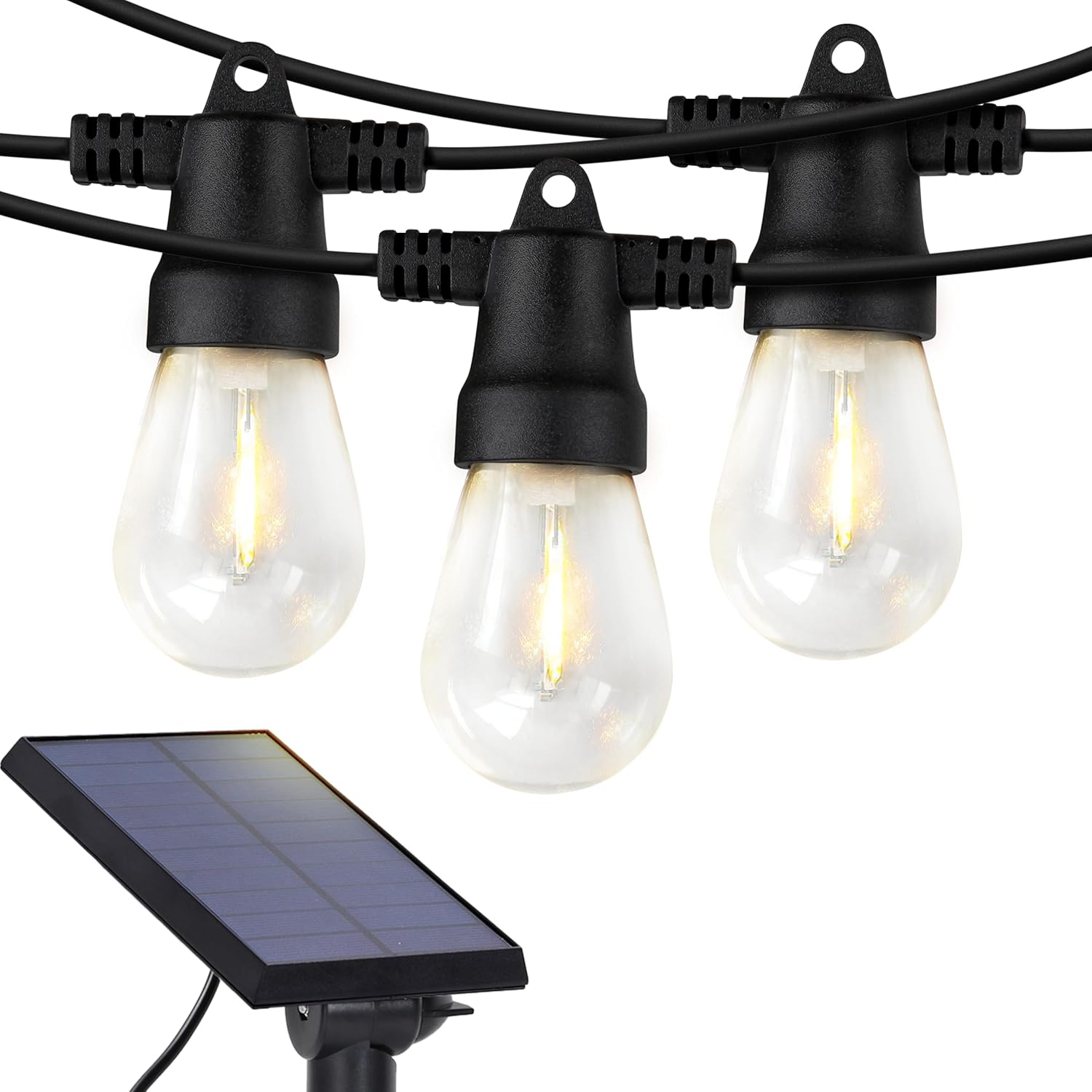
These string lights are a favorite for creating a warm and cozy atmosphere in outdoor spaces. Their vintage-style Edison bulbs offer a timeless aesthetic.
Details:
- Features 12 shatterproof bulbs on a 20-foot string.
- Solar panel can be clipped or staked for flexible positioning.
- IP65 weatherproof rating, designed to handle rain and wind.
Ideal for patios, gardens, and parties, these lights provide a soft, warm glow perfect for creating ambiance. They’re durable and can withstand tough weather while maintaining their charm.
For best results, they require several hours of direct sunlight, so cloudy conditions may affect performance.
LITOM Solar Landscape Spotlights
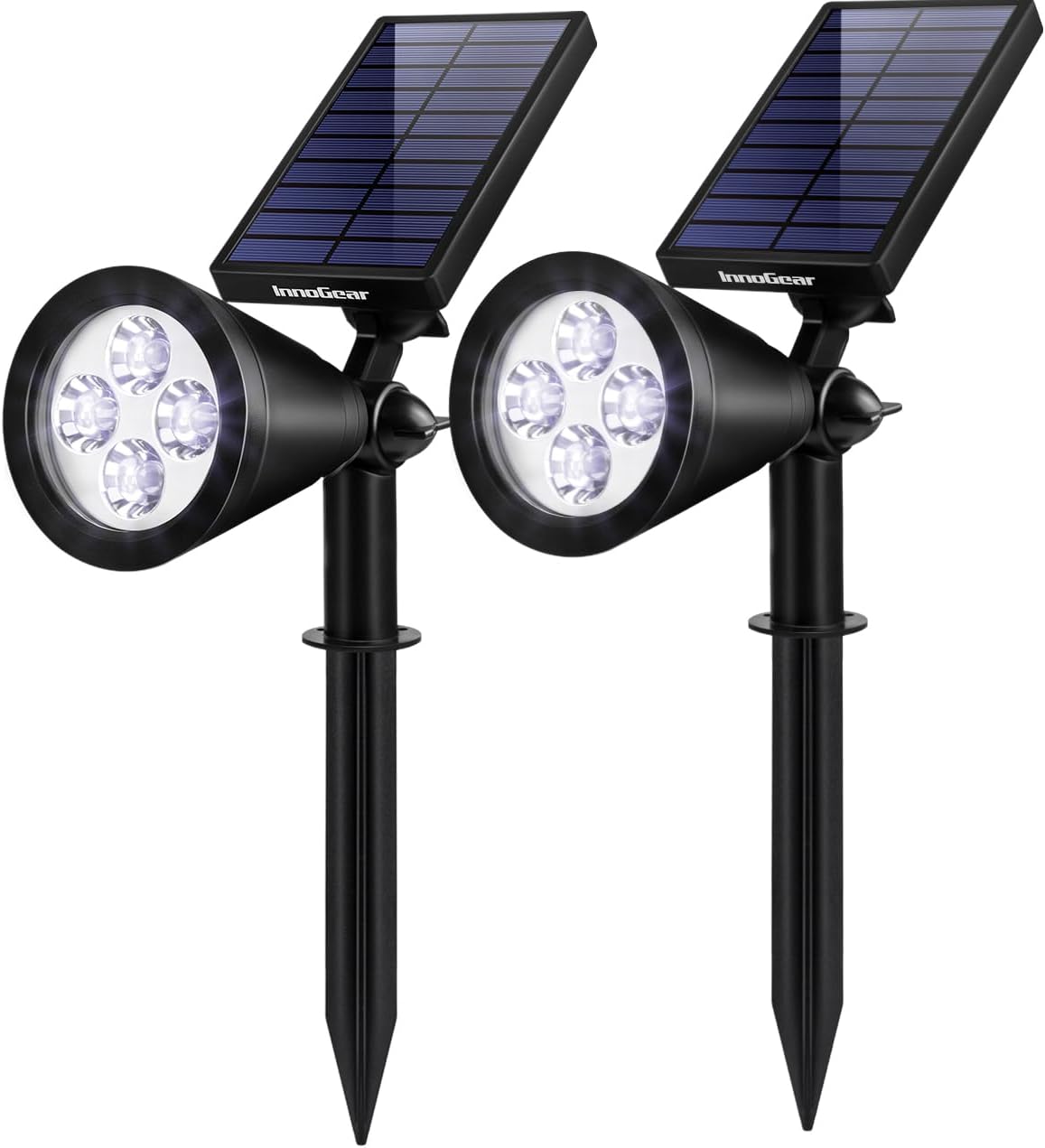
These versatile spotlights are designed to highlight specific outdoor features such as trees, statues, or architectural elements with focused lighting.
Details:
- Two lighting modes: low mode (longer runtime) and high mode (brighter light).
- Adjustable heads offering 90° flexibility for targeted illumination and a 180° solar panel adjustment for optimal sunlight capture.
- IP65 waterproof rating, ensuring durability in various weather conditions.
The InnoGear Solar Spotlights are perfect for accentuating landscaping or decor. Their dual-mode feature lets you switch between ambiance lighting and bright, focused illumination based on your needs.
While highly effective, they may require 6–8 hours of direct sunlight for a full charge, which could be a limitation in cloudy weather.
Aootek Solar Security Lights
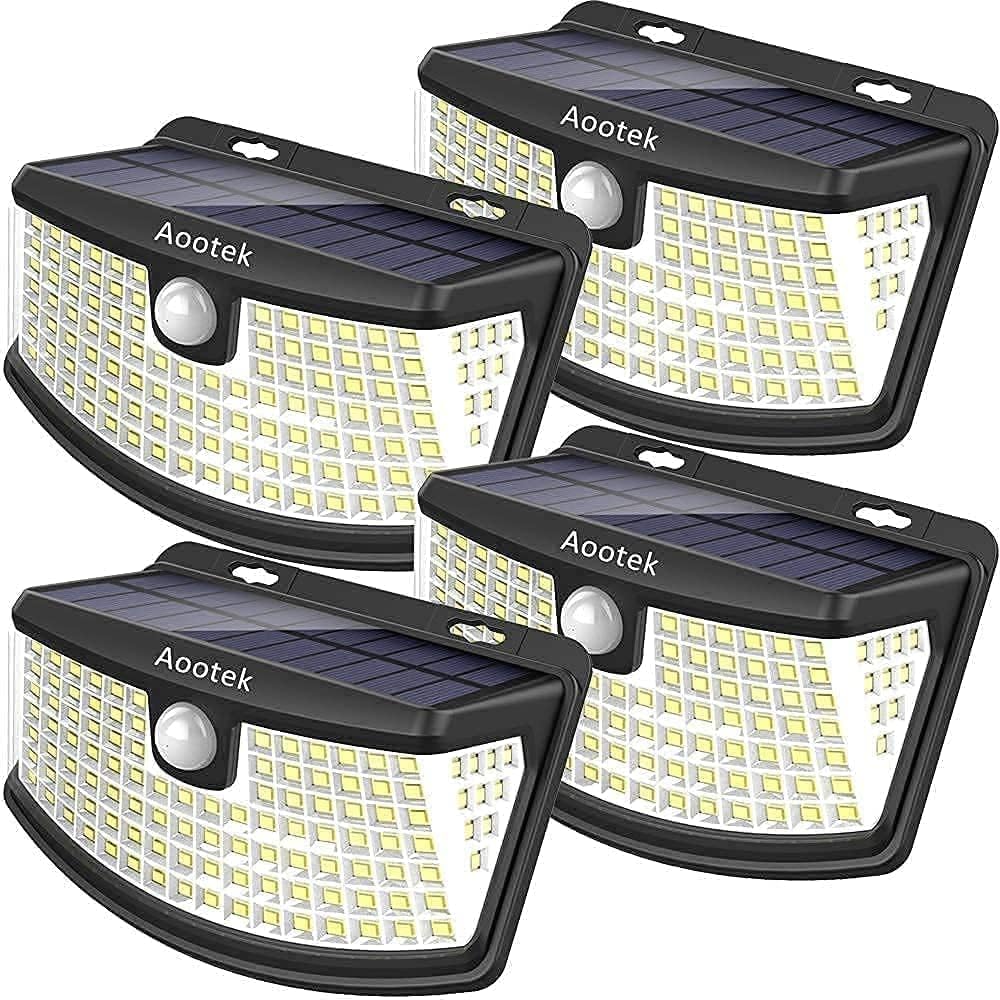
These high-powered lights are designed to cover large areas with bright illumination, making them an excellent choice for security.
Details:
- Equipped with 128 ultra-bright LED chips providing a wide coverage area.
- Features three modes: motion-activated, always-on, and dim + motion-activated.
- IP65 waterproof and heatproof design ensures durability.
The customizable lighting modes make these lights suitable for multiple uses, from securing parking spaces to lighting backyards.
The intense brightness may not be ideal for smaller, decorative spaces.
GIGALUMI Solar Pathway Lights
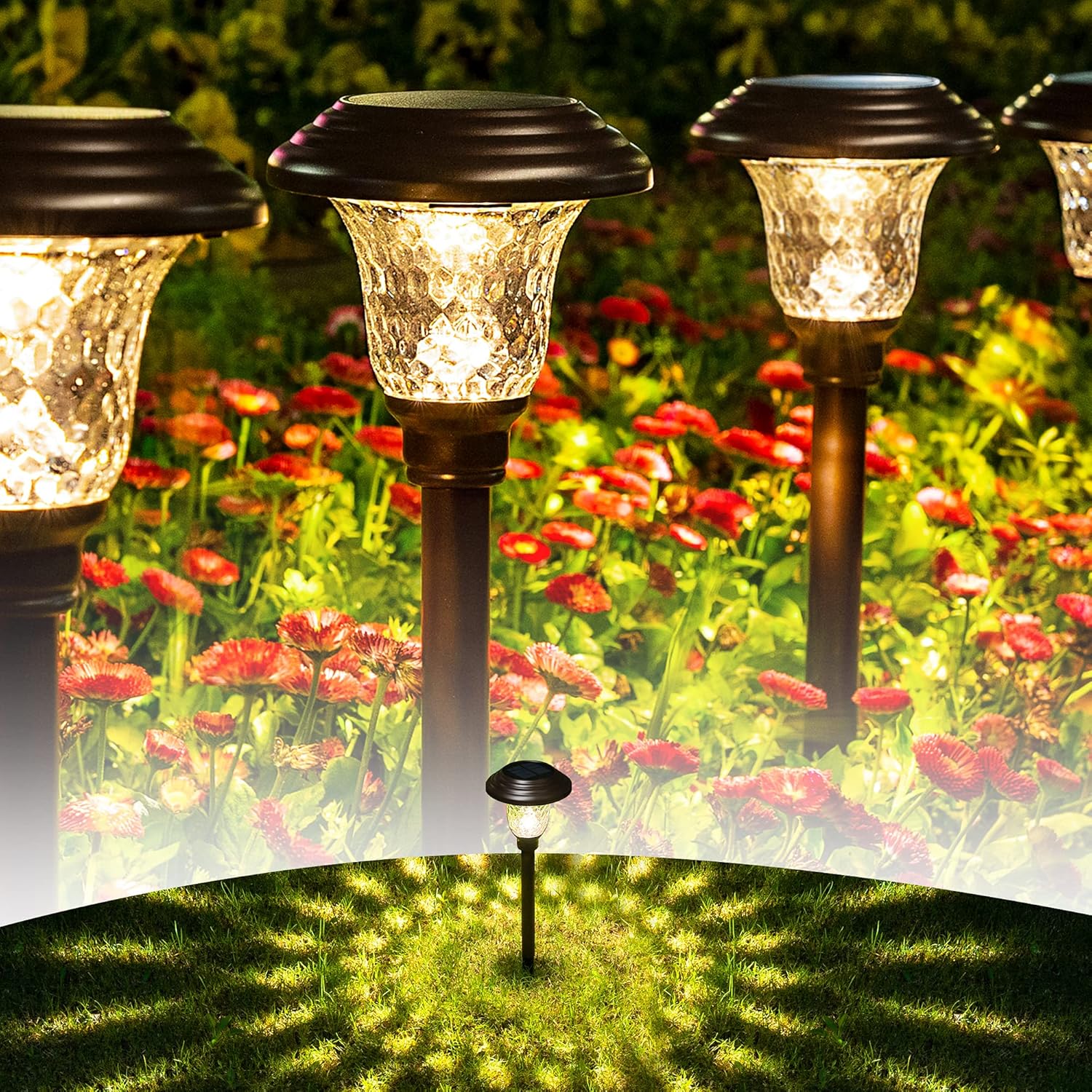
These elegant lights provide a subtle glow that’s ideal for marking paths, driveways, or garden edges.
Details:
- Crafted from durable stainless steel with a warm white LED light.
- Automatic dusk-to-dawn functionality for convenience.
- Easy installation with no wiring required—just stake them into the ground.
Their sleek design blends seamlessly with outdoor decor, making them perfect for adding a touch of sophistication to walkways and gardens.
The brightness is low, so these lights are more about style than intense illumination.
TomCare Solar Flickering Flame Torch Lights
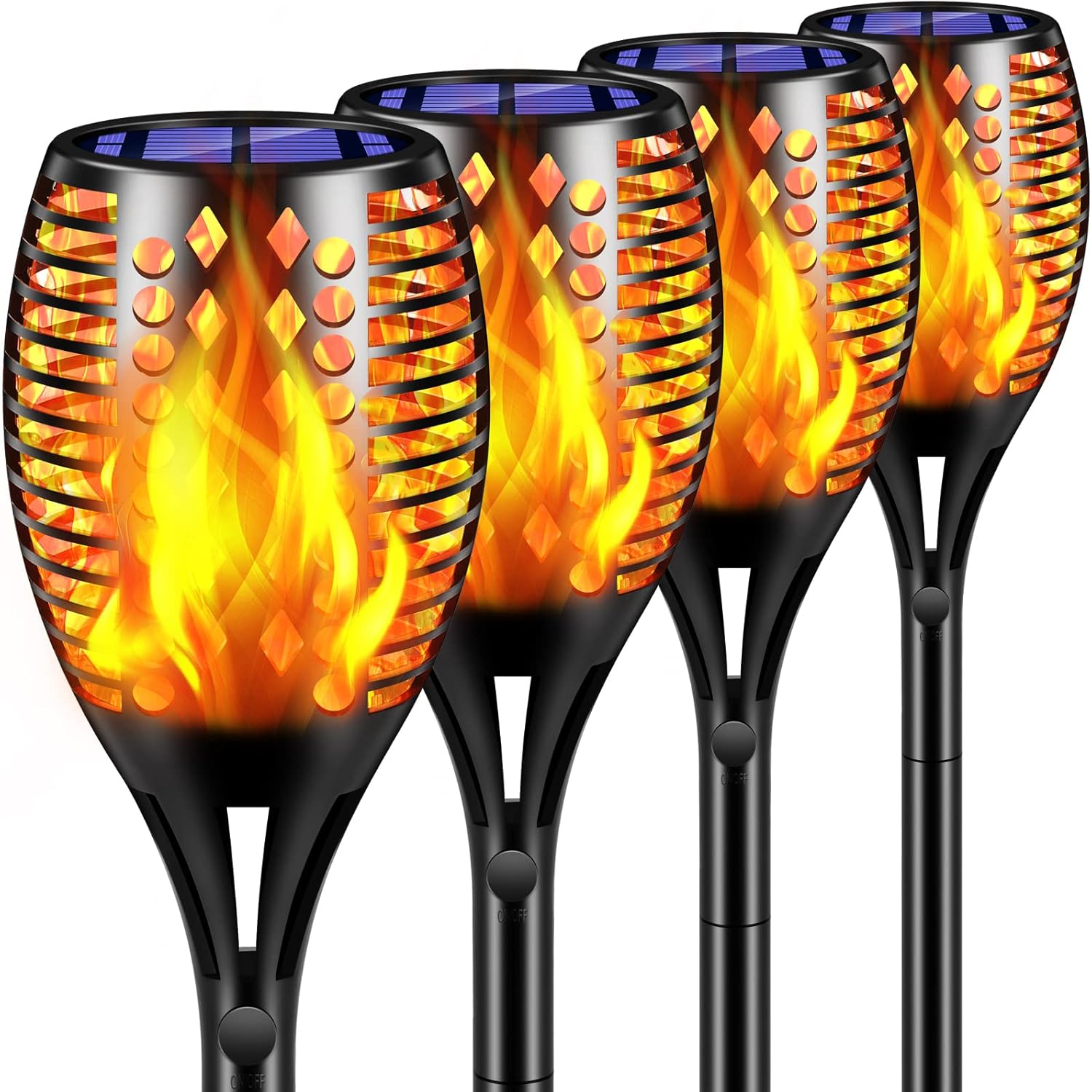
These unique torch lights mimic the look of real flames, adding a dramatic and decorative flair to your outdoor space.
Details:
- Realistic flickering flame effect creates a warm and inviting atmosphere.
- Long battery life offers up to 10 hours of runtime after a full charge.
- IP65 waterproof design ensures performance in rain or snow.
They’re perfect for creating a campfire-like vibe without the fire hazard, making them ideal for gardens, patios, or outdoor events.
These lights are purely decorative and may not provide sufficient brightness for functional needs.
Baxia Technology Solar Motion Sensor Lights

Compact and efficient, these lights offer reliable security lighting at an affordable price.
Details:
- Equipped with 28 LED lights producing 400 lumens of brightness.
- Motion detection range of up to 16 feet.
- IP65 waterproof and heatproof design for outdoor durability.
These lights are a great budget-friendly option for securing smaller spaces like sidewalks, fences, or entryways.
The compact size means the light coverage is more limited compared to larger models.
Trends in Solar Lighting Technology
Solar lighting technology is evolving rapidly, offering more efficient, versatile, and user-friendly solutions than ever before. These trends are shaping the future of outdoor lighting, making it smarter and more adaptable to a variety of needs. Here’s a closer look at the key advancements and how they can benefit you:

Smarter Solar Lights with IoT Integration
Modern solar lights are becoming smarter with the integration of Internet of Things (IoT) technology. These smart lights can be controlled remotely via mobile apps or voice assistants like Alexa and Google Assistant.
Features:
- Remote control of brightness, modes, and schedules.
- Real-time energy usage tracking.
- Automation options, such as syncing with sunrise and sunset times.
IoT integration makes solar lighting more convenient and customizable, allowing you to optimize energy use and tailor lighting to your lifestyle.
High-Efficiency Solar Panels
Advancements in solar panel technology are increasing energy conversion rates, even in low-light conditions. New materials like perovskite and bifacial panels are pushing efficiency to new levels.
Key Benefits:
- Faster charging times.
- Improved performance in cloudy or shaded areas.
- Enhanced durability and lifespan.
High-efficiency panels ensure that your solar lights work reliably regardless of weather or season, reducing downtime and maximizing output.
Hybrid Power Systems
Hybrid solar lights are becoming more common, offering dual power sources that combine solar energy with rechargeable batteries or traditional electricity.
Features:
- Seamless switching between solar and backup power.
- Reliable performance during extended cloudy periods or in shaded areas.
- Reduced reliance on grid electricity while ensuring 24/7 lighting.
Hybrid systems provide the best of both worlds, ensuring uninterrupted illumination without sacrificing energy efficiency.
Enhanced Battery Technology
Batteries are a crucial component of solar lights, and new innovations are significantly improving their performance. Technologies like lithium-ion phosphate (LiFePO4) batteries and solid-state batteries are leading the way.
Key Benefits:
- Longer lifespans and faster charging.
- Higher energy density for extended runtime.
- Safer and more eco-friendly battery options.
Advanced batteries make solar lights more reliable and cost-effective, reducing the need for frequent replacements.
Advanced LED Lighting Options
LED technology is continually improving, offering brighter, more efficient, and customizable lighting solutions.
New Trends in LEDs:
- Color-changing LEDs: Adjust colors to suit different moods or occasions.
- Dynamic brightness control: Automatically dims or brightens based on the surrounding light.
- Directional LEDs: Provide focused illumination without light spillage.
Better LEDs enhance the versatility of solar lights, allowing them to meet both decorative and functional needs with minimal energy consumption.
Durable and Eco-Friendly Materials
Sustainability is a growing focus in solar lighting, with manufacturers turning to recyclable and biodegradable materials.
Examples:
- Recycled plastics and metals for housing.
- Glass solar panels with longer lifespans and reduced environmental impact.
Eco-friendly designs align with the environmental benefits of solar energy, making your purchase a more sustainable choice.
Customizable Designs and Modular Systems
As consumer preferences evolve, solar lighting is becoming more adaptable to personal style and specific needs.
Emerging Features:
- Interchangeable components: Swap out solar panels, batteries, or LEDs as needed.
- Expandable systems: Add more lights to a single solar panel setup.
- Aesthetic innovations: Sleek, modern designs that blend seamlessly with any decor.
Customizable options allow you to tailor your solar lighting to match your outdoor space and lighting requirements perfectly.
Integration with Renewable Energy Grids
Solar lighting systems are now being designed to integrate with larger renewable energy networks.
What’s new:
- Grid-tied systems: Excess energy generated by solar lights can be fed back into the grid.
- Community lighting setups: Shared solar systems for neighborhoods or public spaces.
These integrations maximize the use of renewable energy and encourage a more sustainable approach to outdoor lighting.
These advancements in solar lighting technology make outdoor lights more efficient, reliable, and user-friendly. They cater to modern needs like convenience, sustainability, and design flexibility. Whether you’re upgrading your current setup or planning a new installation, these trends ensure that solar lighting remains a cutting-edge and eco-conscious choice.
Solar Lights vs. Traditional Outdoor Lights
When deciding how to light up your outdoor spaces, you may wonder whether to choose solar-powered lights or traditional electric lights. Each has its own advantages and limitations, depending on your needs and preferences. Here’s a detailed comparison to help you make an informed decision.
Energy Source and Costs
Solar Lights
- Energy Source: Powered by sunlight, making them completely independent of the electrical grid.
- Costs: No ongoing electricity bills; the initial investment covers the light, solar panel, and battery.
- Savings: Over time, they save money by eliminating energy costs.
Traditional Outdoor Lights
- Energy Source: Rely on electricity from the grid.
- Costs: Ongoing expenses for energy usage; electricity bills can add up significantly over time.
- Savings: Typically lower upfront costs compared to solar lights but higher operating costs in the long run.
Solar lights are more cost-effective in the long term, while traditional lights have lower upfront costs.
Installation and Maintenance
Solar Lights
- Installation: Easy and DIY-friendly; no wiring required.
- Maintenance: Minimal, with occasional cleaning of solar panels and battery replacements every few years.
- Flexibility: Can be installed anywhere with sufficient sunlight, even in remote areas.
Traditional Outdoor Lights
- Installation: May require professional help, especially for wiring and electrical connections.
- Maintenance: Higher maintenance costs due to potential electrical issues or bulb replacements.
- Flexibility: Limited to areas with access to electrical outlets or wiring.
Solar lights are easier and more versatile to install, especially in off-grid locations.
Environmental Impact
Solar Lights
- Impact: Eco-friendly, as they rely on renewable energy and produce no emissions during operation.
- Materials: Many are now made with recyclable or sustainable materials.
Traditional Outdoor Lights
- Impact: Depend on electricity, often generated from fossil fuels, contributing to greenhouse gas emissions.
- Materials: Often made with less environmentally conscious materials.
Solar lights are far better for the environment.
Performance and Reliability
Solar Lights
- Performance: Depend on sunlight, so their brightness and runtime may decrease during cloudy weather or shorter days.
- Reliability: Best suited for areas with consistent sunlight; advanced models with hybrid power can compensate for low sunlight.
Traditional Outdoor Lights
- Performance: Deliver consistent brightness regardless of weather conditions.
- Reliability: Dependable as long as they’re connected to a stable power source.
Traditional lights are more reliable in areas with low sunlight or harsh weather conditions.
Brightness and Light Quality
Solar Lights
- Brightness: Generally range from 10 lumens for decorative lights to 2000+ lumens for high-performance models.
- Light Quality: Advances in LED technology mean solar lights now offer high-quality, focused lighting.
Traditional Outdoor Lights
- Brightness: Offer higher and more consistent brightness levels, especially for large spaces or intense applications.
- Light Quality: Often brighter and more customizable in terms of color and intensity.
Traditional lights are better for high-intensity applications, but solar lights are catching up with advanced LEDs.
Lifespan and Durability
Solar Lights
- Lifespan: LEDs in solar lights can last up to 50,000 hours, but the rechargeable batteries may need replacement every 2–5 years.
- Durability: Built to withstand outdoor conditions, with many models featuring waterproof and weatherproof designs.
Traditional Outdoor Lights
- Lifespan: Dependent on bulb type (e.g., halogen, incandescent, or LED); some bulbs may burn out faster.
- Durability: Require robust fixtures to endure outdoor environments.
Solar lights generally have a longer lifespan for the lighting elements, but batteries may require more frequent attention.
Which One Should You Choose?
If you value energy efficiency, environmental benefits, and easy installation, solar lights are the clear winner. They’re ideal for decorative purposes, smaller spaces, and areas without electrical access.
However, if you need consistent, high-powered lighting or live in a region with limited sunlight, traditional outdoor lights may be more suitable for your needs.
Ultimately, the choice depends on your specific requirements, location, and budget. Combining both types can also be an effective way to balance cost-efficiency and performance.
Conclusion
Solar-powered outdoor lighting is an innovative, eco-friendly solution for illuminating your outdoor spaces. From enhancing the beauty of your garden with decorative lights to ensuring safety with motion-sensor security lights, these versatile options cater to various needs. By harnessing the power of the sun, solar lights reduce energy costs, minimize environmental impact, and offer hassle-free installation.
In this guide, we’ve explored everything you need to know about solar lighting: how it works, the different types available, key features to look for, and the latest technological trends. Whether you’re choosing durable pathway lights, stylish string lights, or high-powered floodlights, the right solar lighting can transform your outdoor spaces into functional and beautiful areas.
While solar lights have distinct advantages in terms of sustainability and cost-efficiency, traditional outdoor lights still hold value in certain high-intensity or weather-challenging scenarios. Understanding your needs, the space you want to illuminate, and the local climate will help you decide the best lighting solution.
With advancements in solar technology and an increasing variety of designs, now is the perfect time to embrace this sustainable option. Whether you’re prioritizing security, ambiance, or practicality, solar-powered outdoor lighting offers a reliable and environmentally conscious way to brighten your surroundings.
